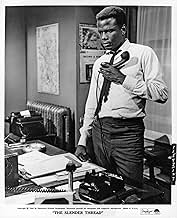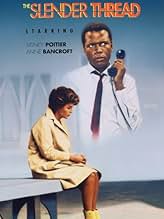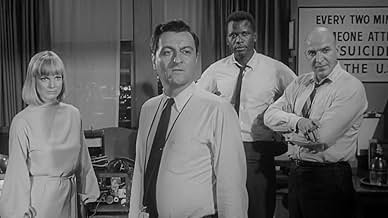NOTE IMDb
7,0/10
2,6 k
MA NOTE
Un soir, Alan, bénévole au collège, travaille seul au centre de crise lorsqu'il reçoit un appel téléphonique d'Inga Dyson, une personne suicidaire.Un soir, Alan, bénévole au collège, travaille seul au centre de crise lorsqu'il reçoit un appel téléphonique d'Inga Dyson, une personne suicidaire.Un soir, Alan, bénévole au collège, travaille seul au centre de crise lorsqu'il reçoit un appel téléphonique d'Inga Dyson, une personne suicidaire.
- Réalisation
- Scénario
- Casting principal
- Nommé pour 2 Oscars
- 2 victoires et 4 nominations au total
H.M. Wynant
- Doctor Morris
- (as H.N. Wynant)
Bob Hoy
- Patrolman Steve Peters
- (as Robert Hoy)
Avis à la une
Sydney Pollack's first feature directorial debut after years of directing episodic television is crisp, tense, and generally very well-acted. Anne Bancroft plays a woman facing a turning point hard to cope with in her life and Sidney Poitier plays a young college student raking in hours at a suicide hot-line extending a figurative helping hand. Though the two great actors share no scenes together - they have a certain chemistry as they talk, talk, and talk on the phones, and we are given flashback sequences showing us how and why Bancroft is fighting her new found depression. Though the story itself is rather mundane in terms of the impetus for her disposition, the dialog and performances easily make up for any inadequacies. Both Bancroft and Poitier really shine in their roles and the rest of the cast - especially Telly Savalas do fine work. It is evident that Pollack was honing his craft but also possessed a great deal of ability in terms of framing a shot and creating a strong pace and presence throughout the picture.
This film tackles subject matter which we still do not see addressed as often as it could be, with Sidney Poitier as a young suicide hot-line worker/college student who works helping out a Seattle psychiatrist Dr. Coburn (well-portrayed by Telly Savalas).
At the time this was even more of a taboo subject. A housewife feeling despair, Bancroft portrays her alienation and desperation sympathetically and in an understated manner. She has a child from her first boyfriend, concealed this from her husband (well-portrayed by Steven Hill) Her husband becomes angry and she begins to feel as if her life is a sham. Her office job no longer satisfying, she takes to wandering the city of Seattle, there are several intriguing scenes of the coastline.
There is one moving scene where she is on the beach and comes across a small group of children who are trying to rescue an injured bird. She rushes to a liquor store to buy some brandy (not sure how this can quite help the bird, but anyway...) she returns to the beach to find the children have abandoned the bird. It is an effective and disturbing scene.
Poitier is outstanding as usual, in that he is trying to locate Bancroft when she calls threatening suicide. She has checked into the Hyatt Hotel somewhere in the city. He becomes alternately frustrated, caring, sympathetic, angry and joyous in various aspects of the film.
Overall this is an excellent film with some very good performances. Highly recommended. 9/10.
At the time this was even more of a taboo subject. A housewife feeling despair, Bancroft portrays her alienation and desperation sympathetically and in an understated manner. She has a child from her first boyfriend, concealed this from her husband (well-portrayed by Steven Hill) Her husband becomes angry and she begins to feel as if her life is a sham. Her office job no longer satisfying, she takes to wandering the city of Seattle, there are several intriguing scenes of the coastline.
There is one moving scene where she is on the beach and comes across a small group of children who are trying to rescue an injured bird. She rushes to a liquor store to buy some brandy (not sure how this can quite help the bird, but anyway...) she returns to the beach to find the children have abandoned the bird. It is an effective and disturbing scene.
Poitier is outstanding as usual, in that he is trying to locate Bancroft when she calls threatening suicide. She has checked into the Hyatt Hotel somewhere in the city. He becomes alternately frustrated, caring, sympathetic, angry and joyous in various aspects of the film.
Overall this is an excellent film with some very good performances. Highly recommended. 9/10.
Sidney Poitier and Anne Bancroft do not have any scenes together in this movie, which is about his attempts to keep her on the telephone long enough to trace the call, since she's just taken an overdose of pills. It may sound stagnant but it never is - there is some great cinematography and location shooting (in Seattle). A lot of the story is flashbacks, as you find out why Anne has tried to off herself. Her performance is poignant and she never overdoes it; Sidney is perfect, as always.
Tech credits are first rate - scoring by Quincy Jones, costumes by Edith Head, and a Westmore on make-up. I believe this was the first directing job by Sydney Pollack - he did a nice job.
Its okay that the stars never met, they met in real life - Bancroft presented Sidney with his only Oscar, for "Lilies of the Field" two years earlier. And this would make a good double-bill with "'night, Mother", in which Bancroft is on the other end of a suicide attempt.
Tech credits are first rate - scoring by Quincy Jones, costumes by Edith Head, and a Westmore on make-up. I believe this was the first directing job by Sydney Pollack - he did a nice job.
Its okay that the stars never met, they met in real life - Bancroft presented Sidney with his only Oscar, for "Lilies of the Field" two years earlier. And this would make a good double-bill with "'night, Mother", in which Bancroft is on the other end of a suicide attempt.
I enjoyed the film not only for its taught and gripping story line; but also for the director's imaginative filming technique. The Slender Thread is unique in it's actual "threading" of actors, particularly, who become much bigger in life as their careers flourish. I always enjoy the chance to see an actor/actress before they go on to fame. Stephen Hill is one of those.
Although not a true film noir; the black and white filming for me adds to the total involvement of the viewer and gives a heightened perspective to the whole cinema outing.
I suggest the film highly. The interactions between cast are worth the view.
Although not a true film noir; the black and white filming for me adds to the total involvement of the viewer and gives a heightened perspective to the whole cinema outing.
I suggest the film highly. The interactions between cast are worth the view.
...even if it couldn't be made today, at least the way it was made then.
It was a terrific suspense movie that had the added benefit of showing Poitier in a totally race-neutral role as young psychology student Alan Newell who is volunteering at the local suicide hotline crisis center on a night that he has every reason to believe will be quiet...and then Inga Dyson (Ann Bancroft) calls him. She has just taken a bottle of barbiturates, does not want to be rescued, but does want to talk. So Alan has to keep his cool and keep Inga on the line long enough to be found, and she only has about 90 minutes to live.
What makes this movie totally anachronistic today is that the entire plot centers around a coordinated effort by scores of public servants in Seattle to trace Inga's phone number and save her before the pills do their job. Of course it would take about 10 seconds for the line to be traced today, which would kind of do away with the suspense.
The suspense is that her call COULD be traced, but it requires the huge telephone company building with countless thousands of connecting plugs and wires that had to be narrowed down, plus the police and fire departments and the State Department of Motor Vehicles, in order to locate the caller's number and where she was calling from. It was like a giant public works department that gave employment to pretty much every proactive player we see in the movie.
In the character development department we have a conversation between Alan an Inga in which we see how she got to the point of despair. It is one part of unforgiveness on her husband's part for a deed done before they were ever married, too much time on Inga's hands one day as the husband continues to stay emotionally detached from her as though she is some unclean thing, the fact that she wanted to talk to somebody about how she felt but could find nobody who would, and the final straw involves the death of an injured bird that is regarded callously by those around her while she tries to help.
In addition to Poitier and Bancroft, Steven Hill gives a chilling and highly credible performance as the unforgiving husband who's driven Bancroft to her suicide attempt. He's such a creepy character that he makes us almost want to force him to swallow those pills instead, and that's a sign that he plays the part to perfection.
Highly recommended because the emotions still ring true even if the technology is long gone.
It was a terrific suspense movie that had the added benefit of showing Poitier in a totally race-neutral role as young psychology student Alan Newell who is volunteering at the local suicide hotline crisis center on a night that he has every reason to believe will be quiet...and then Inga Dyson (Ann Bancroft) calls him. She has just taken a bottle of barbiturates, does not want to be rescued, but does want to talk. So Alan has to keep his cool and keep Inga on the line long enough to be found, and she only has about 90 minutes to live.
What makes this movie totally anachronistic today is that the entire plot centers around a coordinated effort by scores of public servants in Seattle to trace Inga's phone number and save her before the pills do their job. Of course it would take about 10 seconds for the line to be traced today, which would kind of do away with the suspense.
The suspense is that her call COULD be traced, but it requires the huge telephone company building with countless thousands of connecting plugs and wires that had to be narrowed down, plus the police and fire departments and the State Department of Motor Vehicles, in order to locate the caller's number and where she was calling from. It was like a giant public works department that gave employment to pretty much every proactive player we see in the movie.
In the character development department we have a conversation between Alan an Inga in which we see how she got to the point of despair. It is one part of unforgiveness on her husband's part for a deed done before they were ever married, too much time on Inga's hands one day as the husband continues to stay emotionally detached from her as though she is some unclean thing, the fact that she wanted to talk to somebody about how she felt but could find nobody who would, and the final straw involves the death of an injured bird that is regarded callously by those around her while she tries to help.
In addition to Poitier and Bancroft, Steven Hill gives a chilling and highly credible performance as the unforgiving husband who's driven Bancroft to her suicide attempt. He's such a creepy character that he makes us almost want to force him to swallow those pills instead, and that's a sign that he plays the part to perfection.
Highly recommended because the emotions still ring true even if the technology is long gone.
Le saviez-vous
- AnecdotesThis film shows the tedious process in 1965 of what was required in tracing a telephone call on actual central office equipment that was state of the art such as number 5 cross bar and step-by-step electro/mechanical equipment. It was filmed in central offices of the old Northwest Bell Telephone company which as of 2010 is now Century Link. Modern telephone switching equipment can trace a call in less than a minute or even 30 seconds.
- GaffesAfter Inga attempts suicide by drowning herself in the bay, she arrives at hospital with perfectly styled hair.
- Citations
Mark Dyson: [to Inga] Do you think that not getting caught in a lie is the same as telling the truth?
- ConnexionsFeatured in The Directors: The Films of Sydney Pollack (2000)
Meilleurs choix
Connectez-vous pour évaluer et suivre la liste de favoris afin de recevoir des recommandations personnalisées
- How long is The Slender Thread?Alimenté par Alexa
Détails
- Durée1 heure 38 minutes
- Couleur
- Mixage
- Rapport de forme
- 1.85 : 1
Contribuer à cette page
Suggérer une modification ou ajouter du contenu manquant





































